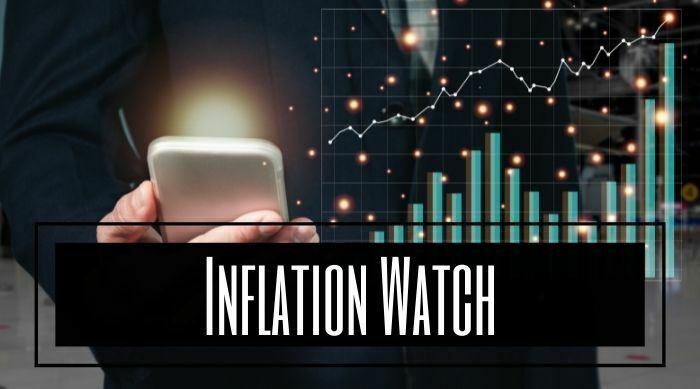Up to date news and analysis on inflation and its impact on the economy and cryptocurrency markets.
Over the last 12 months, the June CPI-U inflation increased increased 9.1 percent and 1.3% year over year. The May CPI-W (which is tied to COLA and Social Security) increased 9.26% year over year and 8.73% in quarter 1 year over year.
The July CPI report will be released on Wednesday, August 10, 2022 at 8:30 am.
Inflation Forecast & Trends

- The Federal Reserve is raising interest rates, including the biggest rate hike since 2000, and thereby attempting to curb rising prices and keeping inflation lower.
- Bank of America analysts have warned that “inflation always precedes recessions.”
- Since Russia invaded Ukraine there is an unforeseen and prolonged fallout for the global economy.
Current Reasons for Inflation
- An increase in the money supply e.g. due to stimulus checks, federal spending
- Global pandemic
- A decrease in the production of goods and services
- An increase in global demand for goods and services
- Supply chain issues
- Rising gas prices/dependency on foreign energy (pre and post Russian invasion)
- Russia invading Ukraine (inflation was rising rapidly prior to the invasion)
Inflation can have both positive and negative effects on an economy:
- Can lead to higher wages and increased spending power for consumers. or;
- Can lead to higher prices for goods and services, which can put strain on businesses and families.
Inflation & Cryptocurrency
It’s natural to think that cryptocurrency is a hedge against inflation. Cryptocurrencies have either fixed number of coins (Bitcoin), capped circulation growth or are even deflationary. Central banks on the other hand can print as much money as they wish. However, as inflation and cost of goods have increased, crypto has decreased and also been volatile. Even better-understood inflation hedges (such as gold) haven’t worked well in this environment, either. A faster-than-expected uptick in prices could spur the Federal Reserve to tighten monetary policy aggressively over the next few months.
In the short historical timeframe for crypto there is very little evidence that crypto does or does NOT hedge against inflation. The only thing that has been clear thus far is that there is a correlation to the crypto markets and inflation as the markets react to the monthly CPI reports.
The Consumer Price Index (CPI) report is a measure of the average change over time in the prices paid by urban consumers for a market basket of consumer goods and services. Stock and Crypto markets monitor this monthly report closely as any volatility in inflation could lead to adverse conditions that could put more downward pressure on risky assets from stocks to Bitcoin (BTC) and other cryptocurrencies.
CPI Report Schedule
| Reference Month | Release Date | Release Time |
|---|---|---|
| October 2021 | Wednesday, Nov. 10, 2021 | 8:30 AM EST |
| November 2021 | Friday, Dec. 10, 2021 | 8:30 AM EST |
| December 2021 | Wednesday, Jan. 12, 2022 | 8:30 AM EST |
| January 2022 | Thursday, Feb. 10, 2022 | 8:30 AM EST |
| February 2022 | Thursday, Mar. 10, 2022 | 8:30 AM EST |
| March 2022 | Tuesday, Apr. 12, 2022 | 8:30 AM EST |
| April 2022 | Wednesday, May 11, 2022 | 8:30 AM EST |
| May 2022 | Friday, Jun. 10, 2022 | 8:30 AM EST |
| June 2022 | Wednesday, Jul. 13, 2022 | 8:30 AM EST |
| July 2022 | Wednesday, Aug. 10, 2022 | 8:30 AM EST |
| August 2022 | Tuesday, Sep. 13, 2022 | 8:30 AM EST |
| September 2022 | Thursday, Oct. 13, 2022 | 8:30 AM EST |
| October 2022 | Thursday, Nov. 10, 2022 | 8:30 AM EST |
| November 2022 | Tuesday, Dec. 13, 2022 | 8:30 AM EST |
2022-2023 COLA & CPI Summary
- The May CPI-W increased 9.26% year over year and 8.73% in quarter 1 year over year.
- The Consumer Price Index for All Urban Consumers (CPI-U) increased 1.3 percent in June on a seasonally adjusted basis after rising 1.0 percent in May.
- Over the last 12 months, the all items index increased 9.1 percent before seasonal adjustment.
- The increase was broad-based, with the indexes for shelter, gasoline, and food being the largest contributors.
- The energy index rose 7.5 percent over the month and contributed nearly half of the all items increase, with the gasoline index rising 11.2 percent and the other major component indexes also rising.
- The food index rose 1.0 percent in June, as did the food at home index.
- The index for all items less food and energy rose 0.7 percent in June, after increasing 0.6 percent in the preceding two months.
- While almost all major component indexes increased over the month, the largest contributors were the indexes for shelter, used cars and trucks, medical care, motor vehicle insurance, and new vehicles.
- The indexes for motor vehicle repair, apparel, household furnishings and operations, and recreation also increased in June.
- Among the few major component indexes to decline in June were lodging away from home and airline fares.
- The increase was broad-based, with the indexes for shelter, gasoline, and food being the largest contributors.
- The all items index increased 9.1 percent for the 12 months ending June, the largest 12-month increase since the period ending November 1981.
- The all items less food and energy index rose 5.9 percent over the last 12 months. The energy index rose 41.6 percent over the last year, the largest 12-month increase since the period ending April 1980.
- The food index increased 10.4 percent for the 12-months ending June, the largest 12-month increase since the period ending February 1981.
Source: U.S. Bureau of Labor Statistics Consumer Price Index News Release
CPI-W vs CPI-U
The CPI-W is used to calculate Social Security cost-of-living adjustments and other federal benefit programs, most other COLAs cited in federal legislation, such as the indexation of federal income tax brackets, uses the CPI-U. When only CPI is stated and CPI inflation reports are announced it is in reference to the CPI-U. The CPI-U report is always released first and the CPI-W report is typically released several days later.
Consumer Price Index for All Urban Consumers (CPI-U)
The CPI-U is a more general index and seeks to track retail prices as they affect all urban consumers. It encompasses about 87 percent of the United States’ population.
Consumer Price Index for Urban Wage Earners and Clerical Workers (CPI-W)
The CPI-W is a more specialized index and seeks to track retail prices as they affect urban hourly wage earners and clerical workers. It encompasses about 32 percent of the United States’ population and is a subset of the CPI-U group.
The CPI-W places a slightly higher weight on food, apparel, transportation, and other goods and services. It places a slightly lower weight on housing, medical care, and recreation.
COLA (Cost-of-Living Adjustment)
The May 2022 COLA measurement is currently 7.30% higher than the 2022 official measurement. While the official measurement period is Quarter 3 2022 this is indicative of a pace towards a significant COLA increase in 2023
| 2021 Q3 Average | June 2022 | Increase |
| 268.421 | 288.022 | 5.50% |
Monthly CPI-W
| Monthly CPI-W for 2021 and 2022 | 2021 | 2022 | YoY Increase |
| January | 255.296 | 276.296 | 8.23% |
| February | 256.843 | 278.943 | 8.60% |
| March | 258.935 | 283.176 | 9.36% |
| April | 261.237 | 261.237 | 8.93 |
| May | 263.612 | 288.022 | 9.26 |
| June | 266.412 | TBD | TBD |
| July | 267.789 | TBD | TBD |
| August | 268.387 | TBD | TBD |
| September | 269.086 | TBD | TBD |
| October | 271.552 | TBD | TBD |
| November | 273.042 | TBD | TBD |
| December | 254.081 | TBD | TBD |
Quarterly CPI-W
| Quarter | 2021 | 2022 | YoY Increase |
| Quarter 1 | 257.025 | 279.472 | 8.73% |
| Quarter 2 | 263.754 | TBD | TBD |
| Quarter 3 | 268.421 | TBD | TBD |
| Quarter 4 | 253.994 | TBD | TBD |
| Annual | 252.248 | TBD | TBD |
2021 (effective 2022) Official COLA Measurement – CPI-W
| Description | 2020 | 2021 |
| July | 252.636 | 267.789 |
| August | 253.597 | 273.567 |
| September | 254.004 | 274.31 |
| Third-quarter total | 760.237 | 815.666 |
| Average (rounded to the nearest 0.001) | 253.412 | 271.889 |
| Inflation According to the CPI-W | 1.30% | 5.90% |
COLA (Cost-of-Living Adjustment) Recipients & Programs
- Social Security recipients (any increase is effective with December 2022 benefits, payable in January 2023)
- Federal Civilian Retirees
- Supplemental Security Income (SSI)
- Social Security Disability Insurance (SSDI)
- Eligibility for Medicare Extra Help and Medicaid
- Federal & State food and housing assistance programs
- Military
- Retired Military Veterans
- Disabled Veterans
- Veterans’ Pension Benefits
- Survivor Benefit Annuitants
- Surviving Families of Veterans
[table id=4 /


